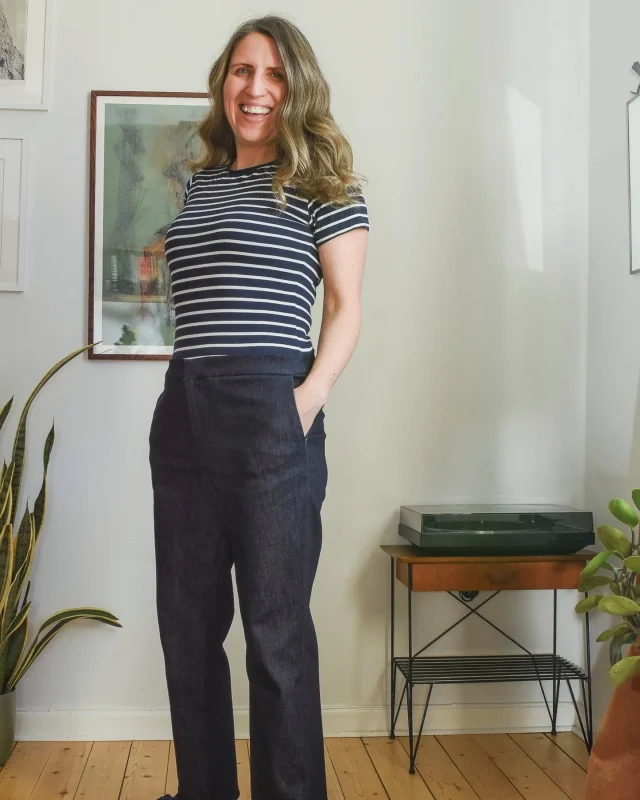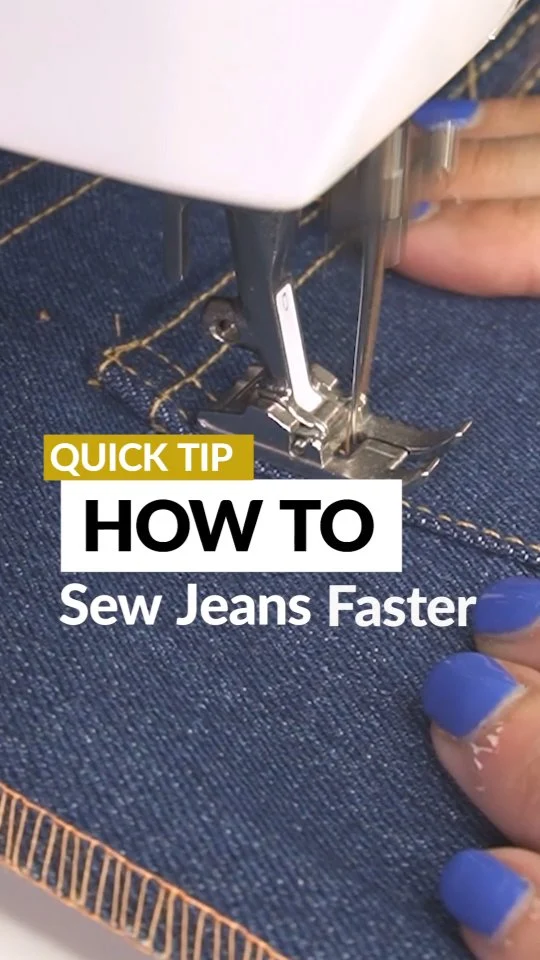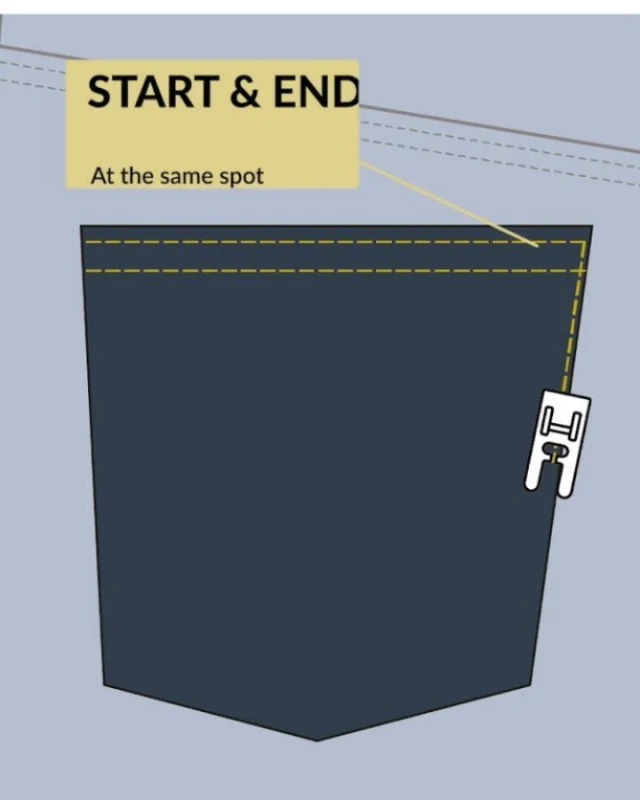
Belt loops on jeans can feel a bit intimidating since it can be hard to get the stitching right on all those bulky layers. But don’t worry, this tutorial will show you how to make sewing belt loops a relatively painless experience, even if you only have a weak domestic sewing machine.
Sewing belt loops: The basics

- Sew one long continuous strip of fabric and then cut the strip into separate belt loop pieces. This makes sewing them both quicker and more consistent.
- Most jeans have five belt loops, one mid-back, two on the sides of the back, (around 3 – 5 cm (1½–2″) from the side seam) and then loops just outside of the front pocket seam on each side.
- The most important consideration when sewing belt loops is that they are long enough to fit the belts that you are intending to wear. The rest is just up to what design and style you prefer.
This post contains Amazon affiliate links, meaning that a commission is earned from qualifying purchases.
Ways to sew belt loops

With a coverstitch machine
In the garment industry, a coverstitch machine is normally used to sew the jeans belt loops. In my book Master the Coverstitch Machine I show two versions of this technique, and my upcoming book about sewing jeans will of course also show this method as well.

With a twin-needle on a sewing machine
Belt loops sewn with a twin-needle is a quick and easy option that can be sewn entirely on the sewing machine. For best result use a special jeans twin-needle and a bias-tape maker (Amazon affiliate links) to create the fold. That said, for really heavy denim the twin-needle might not be strong enough.

Edge stitched triple-layer belt loops
Probably one of the most common methods used by us home sewists and the method I will show in this tutorial. The edges of the belt loop are overcasted, then folded two times so that finished width is ⅓ of the cut strip. To close the loop, the edges are topstitched on a sewing machine.
The main advantage of using this method is the flexibility it offers when it comes to size, thread options and the needles used. It will, however, be bulkier than the versions sewn with a coverstitch or twin-needle.
Learn more: 7 Time-Saving Tips For Sewing Jeans
To sew the belt loops you’ll need
- Sewing machine
- Edge presser foot (optional)
- Serger (optional)
- Press template (optional)
- Topstitching thread for the needle
- Sewing machine thread in the bobbin
- Size 90/14 to 110/18 denim needle or a topstitching needle (see below for more info)

Recommended notions and tools for sewing belt loops
(Amazon affiliate links)

Schmetz Topstitching sewing machine needles with a larger eye (makes a massive difference, see my tutorial on topstitching for more info on why I like this needle so much).
A Jeans/Denim machine needle is fine too if you can’t locate topstitching version.

My favourite denim thread is Gûtermann’s Extra Strong (M782) colour 968. It’s also available as a 30 metre buttonhole thread, but I think the 100 meters one is more value for the money. The 412 colour is nice too, it’s a little bit more bright and rich.
You can get the same colours from Gûtermans Sew-All thread (regular sewing machine thread), which is what I recommend for the bobbin thread to minimise the pain of topstitching on a regular sewing machine. Again check my topstitching tutorial for more info on why,

An edge stitch presser foot is a nice addition and will make topstitching the belt loops easier on your sewing machine. I think pretty much all sewing machine brands have a version of this foot. I have an old Bernina machine that actually has two versions of this foot, the one I have (number 5) also works as a blind hem stitch foot.

Tutorial for sewing the belt loop strip

1. Cut and overcast the denim fabric strip.
The strip should be approximately 3X the finished width. Use a wide serger 3-thread overlock or a sewing machine zigzag or overlock stitch to cover the edges.


2. Fold and press the belt loop strip
To make this easier use a paper press template the same width as the finished belt loop and add a line slightly inside of the edge as a folding guide. Fold 1/3 of the strip, press and fold a second time over the edge. If you are using a press template, wrap the fabric strip around the template and press. The advantage of using a press template is that it makes it easy to make the entire belt loop strip uniform in size.

3. Set up the machine
Use topstitching thread in the needle and regular sewing machine thread in the bobbin. An edge presser foot makes it easier to sew straight, but is certainly not necessary. Begin by stitching the side with the overcasted edge, as this will ensure the edge is properly secured.

Learn more: How to sew perfect topstitching
4. Start sewing along the edge
Begin by stitching the side with the outer overcasted edge, as this will ensure that the edge is properly secured.
5. Stitch the other edge

Finish off by topstitching along the opposite side of the overcasted edge.

The finished loop
This method is really simple and offers you so many options when it comes to stitching and width. And you don’t need a serger to make it happen, a regular sewing machine zigzag will work just as well. Just make it a bit wider than the standard settings.
Attaching the belt loops
The method I’ll show you here makes attaching belt loops easy and precise without any special tools, except maybe a hump-jumper to make sewing over the bumpy loops easier.
To attach the belt loops you’ll need
- Topstitching thread for the needles and regular thread for the bobbin
- Denim or topstitching needle size 100 (16) or 110 (18)
- A hump-jumper to level the presser foot
Tips for sewing belt loops onto the jeans
- If you are having problems stitching over all the layers, use a hump-jumper to level the presser foot
- Try increasing the stitch length of the bartacks to make the feeding smoother.
- Use heavy topstitching thread in the spool, but regular sewing machine thread in the bobbin. This will prevent the thread from getting jammed up.

1. Cut the strip into equal loops and press and fold the edges
The folds should be about 1–1.5 cm (⅜ to ⅝”) wide. Press with an iron to set the folds. There is no need to overcast the edges, they won’t unravel and a slight fraying is part of the look on traditional denim belt loops. Here the belt loops are sewn with a coverstitch machine, which is why the inside looks a bit different than the method shown above.

2. Attach the upper edge of the belt loop.
Sew a row of straight stitching in the ridge of the upper fold. Backstitch to secure. Tip: Use a pin or a dab of basting or stick glue to keep the loop in place if it is slipping.

3. Topstitch along the lower edge
Use a narrow zigzag stitch with a shorter stitch length. Backstitch at the start and the end. For extra security let the stitch extend just outside the edge of the belt loop.
Tip: Hammer down the fabric layers with a mallet to remove bulk. This is can make a big difference if you have problems with the feeding on a domestic sewing machine.
Learn more: 8 Great Tools and Notions for Sewing Jeans

4. Topstitch over the upper edge.
Again use a narrow zigzag stitch with a shorter stitch length and stitch a few millimetres in from the folded edge.

The finished belt loop
I placed the belt loops slightly lower than normal since I really like this as a design feature. But normally belt loops are placed higher up on the waistband.
I hope you found this tutorial helpful to get you started with sewing belt loops on jeans. In my upcoming book about sewing jeans, I show 5 different ways to sew belt loops and I also have tutorials for several different ways to attach them (such as enclosing them in the waistband).
I think the main points to take home is to A: Sew one continuous strip rather than five separate ones and B: To first attach the belt loops with a stitch inside the fold and then do the topstitching over the fold. This saves so much pain in trying to get the loops to stay put on a domestic sewing machine!
Want to learn more jeans sewing techniques? Check out the other tutorials in my jeans making series.
This post contains Amazon affiliate links, meaning that a commission is earned from qualifying purchases.







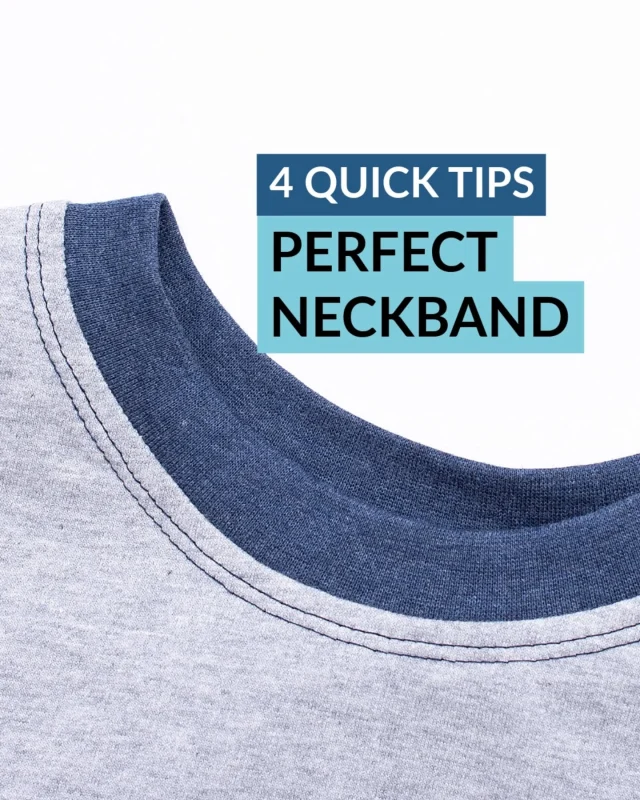
 I used an old shirt for
I used an old shirt for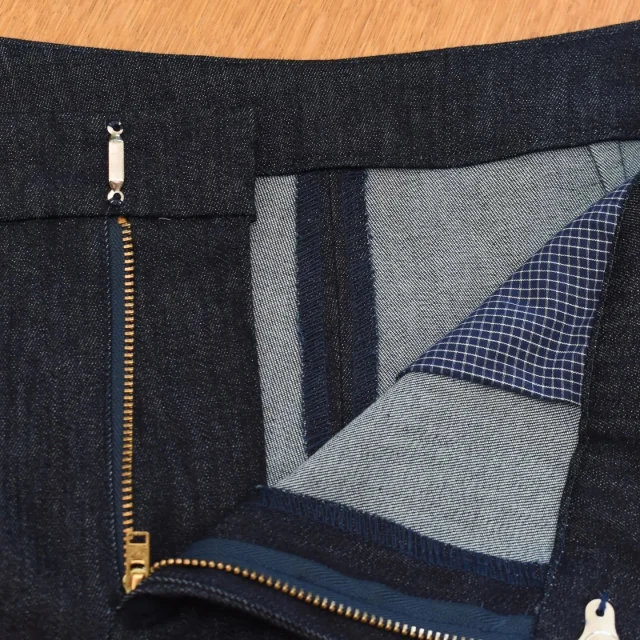
 Pattern is from @burda_sty
Pattern is from @burda_sty